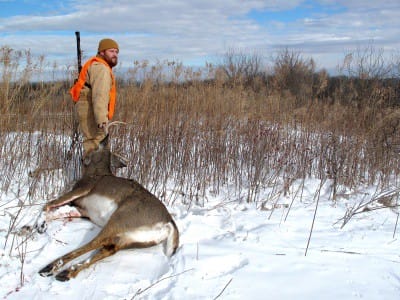
Late season can be tough on a deer hunter. The weather’s colder, the rut is over, deer have been pressured, and quite honestly, for the hard hunting among us, we’re getting tired both physically and mentally. But don’t give up yet. The good news is late season is when some of the biggest bucks fall each year. Here are five strategies to help you pull that rabbit from your hat and still make this a season you’ll never forget.
Go Green or Grain
It’s all about the food, and where the deer are feeding should be your first priority this time of year. Focus attention on green food plots planted with late-season brassicas such as turnips, rape or kale, or late-harvested agricultural crops of corn, soybeans and alfalfa where waste grains litter the ground. Deer will bed close to these areas. In the case of still standing corn, they’ll often bed right in it, because they’ve been pressured hard from hunters and know to travel far not only wastes precious energy, but makes them susceptible to danger. Key on food-rich openings bordered with thick brush, such as a grown-up cutover, tangles of honeysuckle and briar or other cover where deer can walk less than 50 yards between bedding and food. Set up a trail camera or timed plot cam, pinpoint when and where deer are entering the field and when conditions are right, slip in as close as you dare for a shot.
Make the Most of Mast
With food in mind, those stands of oaks that were dropping acorns early in the season may still have plenty of nuts lying beneath the leaves, too. And with many of these areas back in the woods, bucks feel safer and may move when there is still ample shooting light. Focus on water oaks, those tiny acorns that drop from early in the season but often are still falling heavily in December.
Scout out your property’s hottest mast producing spots from early in the season, and look for sign that deer have been digging among the leaves or trampling snow in search of the high protein feed. Hang a stand in the spot with the most disturbance and sit tight early in the morning and late in the afternoon. Deep woods stands over mast may have gone ignored in the evenings early in the season, but now they’re a good bet.
Pinpoint Overlooked Areas
Grab a satellite image of your hunting land and put an X on every stand location or area where hunters have spent time this season. You’ll notice a few bare spots among the ink that went overlooked. That’s where your bucks may be hiding. Now you have to hunt them. Check for well-used deer trails entering these spots that lead toward food, wait until the wind is right, hang a stand and sit it looking to score in the first or final moments of shooting light.

Get Nasty
Watch the weather for a huge, nasty, snow-dropping, wind-spawning Alberta clipper-type storm front about to move in, and you can bet it’s going to put deer on their feet. The nastier the better, so call in sick if you have to, find a shooting house on a good food source or put on your Heater Body Suit to stay warm and do your best to camp out all day. These big fronts are the one time late in the season where deer movement can match that of the rut.
Push the Bush
When all else fails, gather up a few buddies and organize a few well-planned drives. We do this the final day or two of deer season on my Virginia farm and it’s almost always good for putting a big buck or two on the hoof and in front of a gun. In fact, for those bucks that have gone nocturnal due to deer pressure, it may be the only way you’ll ever seem them during shooting hours.
The Union Sportsmen’s Alliance website is designed to provide valuable articles about hunting, fishing and conservation for members of AFL-CIO affiliated labor unions and all sportsmen and sportswomen who appreciate hunting and fishing and want to preserve our outdoor heritage for future generations. If you would like your own story and experience from the outdoors to be considered for our website, please email us at[email protected].







